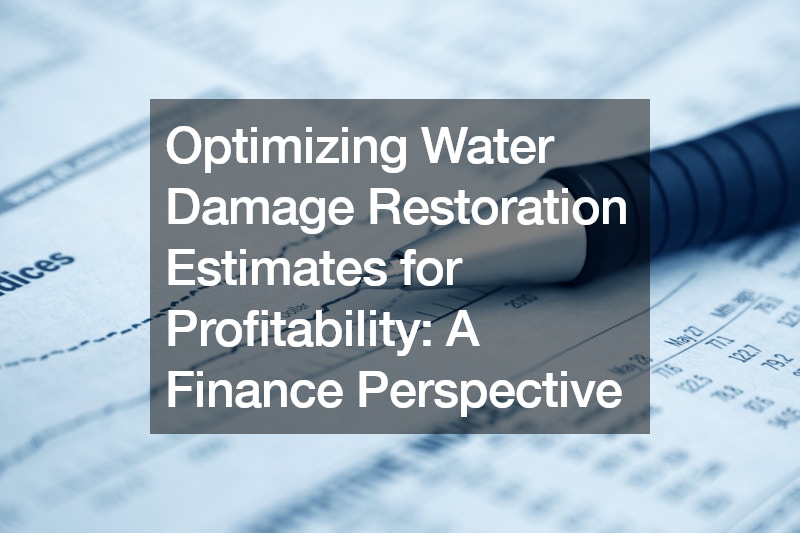
In the aftermath of a water disaster, property owners face a daunting task: assessing the damage, navigating insurance claims, and finding a reputable restoration company to handle the repairs. While emotions run high, accurate estimates for water damage restoration become a crucial decision point. Creating estimates for water damage restoration services involves a delicate balance: ensuring competitive pricing to win the job while maintaining profitability to sustain their business and invest in quality services.
This financial perspective explores strategies for optimizing water damage restoration estimates to maximize profitability without compromising customer satisfaction. Restoration companies can refine their estimates by understanding cost components, employing accurate estimating techniques, prioritizing clear communication, securing more projects, and achieving sustainable long-term profitability.
Ultimately, a win-win scenario is achieved by delivering excellent service, competitive pricing, and a clear understanding of value for both the customer and the restoration company.
Understanding Cost Components: Breaking Down the Estimate
The first step to optimizing estimates is a clear understanding of the cost components involved:
Direct Costs: These are tangible expenses directly linked to the restoration process, including:
Labor Costs: Wages for technicians performing cleaning, drying, and reconstruction work. Materials Costs: Materials like drying equipment, disinfectants, and building materials for repairs. Equipment Costs: Rental or depreciation costs for water removal equipment, moisture meters, and other specialized tools. Indirect Costs: These are hidden expenses that contribute to the overall cost of doing business, including
Overhead Costs: Rent, utilities, insurance, and administrative costs. Marketing and Sales Costs: Expenses incurred to attract new clients. Profit Margin: The percentage of revenue retained after all costs are covered. Estimating with Precision: Tools and Techniques
Creating accurate estimates requires combining industry knowledge, experience, and the right tools. Here are some key strategies:
Xactimate Software: This industry-standard software helps generate detailed estimates by factoring in labor hours, material quantities, and local pricing data. Site Inspection Protocols: Develop standardized protocols for thorough site inspections to identify the full extent of damage and avoid underestimating repair needs. Historical Data Analysis: Analyze past project data to identify cost trends and adjust estimates based on project complexity. Balancing Price with Profit: Strategies for Competitiveness
While profitability is essential, remaining competitive in the market requires careful consideration of pricing strategies:
Competitive Research: Conduct regular research to understand competitor pricing for similar jobs in your area. Tiered Pricing Structures: Different pricing options based on service levels, allowing some flexibility for cost-conscious customers. Value-Added Services: Differentiate your company by offering additional services like mold remediation or content restoration, justifying potentially higher estimates. Transparency and Communication: Building Trust with Customers
Building trust with customers is crucial for securing the job and ensuring positive reviews. Here’s how to achieve transparency in your estimates:
Breakdown of Costs: Provide a detailed breakdown of all cost components in the estimate, allowing customers to understand how their money is spent. Explanation of Scope of Work: Clearly explain the scope of work outlined in the estimate, including the specific services to be provided. Contingency Plans: Discuss potential unforeseen issues and how they would be handled, with associated cost adjustments if necessary. Negotiation Strategies: Maintaining Profitability While Closing Deals
Negotiation is a natural part of the restoration process. Here are some tips for maintaining profitability while addressing customer concerns:
Focus on Value: Emphasize the value and expertise you bring to the project, justifying the proposed price. Highlight Differentiators: Showcase unique services or processes offered by your company compared to competitors. Offer Alternatives: Consider offering alternative solutions like staged repairs or prioritizing urgent fixes to meet budget constraints while maintaining a healthy profit margin. Technology Solutions for Streamlining Estimates
Technology can significantly improve the efficiency and accuracy of estimates:
Mobile Estimating Apps: Utilize mobile apps to capture site photos and damage details and generate estimates on-site, saving time and resources. Cloud-Based Project Management Tools: Consolidate project data, estimates, and communication in a centralized platform for improved efficiency and cost tracking. Conclusion:
Creating profitable estimates is an ongoing process that requires balancing customer satisfaction and financial well-being. Water damage restoration companies can refine their estimating processes, secure more projects, and achieve sustainable long-term profitability by understanding cost components, employing accurate estimating techniques, maintaining competitiveness, and focusing on customer communication. Ultimately, a win-win scenario is achieved by delivering excellent service, competitive pricing, and a clear understanding of value for both the customer and the restoration company.
.




